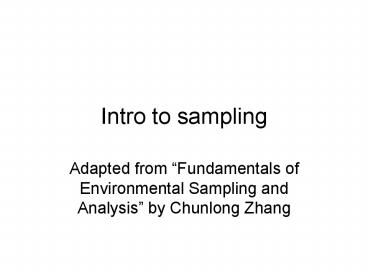Intro to sampling PowerPoint PPT Presentation
1 / 10
Title: Intro to sampling
1
Intro to sampling
- Adapted from Fundamentals of Environmental
Sampling and Analysis by Chunlong Zhang
2
Why are you sampling?
- Comply with regulations!
- Determine concentrations or loads
- Measure background, ambient concentrations
- Determine degree of pollution
- Identify trends (spatial, temporal)
- Detect accidental releases or evaluate risk
- Risk to humans? Wildlife? Both?
- Study fate and transport, evaluate effectiveness
of control or remediation strategies
3
Scientifically defensible data
- Can it stand up in court?
- Components of legal defensibility include (but
are not limited to) - Custody or control (chain of custody forms, to
prevent tampering) - Documentation (paper trail)
- Traceability (esp standards certificates of
analysis)
4
Lab notebooks
- In govt and industry, lab notebooks are LEGAL
DOCUMENTS - Date and signature are part of GLP
- Do not remove pages or obliterate or erase
anything. - In academia, the rules are loose.
- The lab notebook is your journal, diary, best
friend. Make your notes excruciatingly detailed.
- Why? To help YOU when you write up your data
(sometimes years later)
5
Sampling issues
- Where to take samples
- When to take samples
- How to take samples
- How many samples to take
- How often samples will be taken
- How much sample is needed
- How to preserve samples
- How long the sample will be stable
- What to take (air, water, soil?)
- What to analyze (physical, chemical, biological)
- Who will take samples (sample custody)
6
Why is environmental sampling unique?
- Numerous analytes, high cost
- Many samples
- Sample matrices are complex, interferences are
variable and unpredictable. - Concentrations are low
- Some analyses must be done on site and/or
continuously - Analysts need to know not just how to analyze,
but also be familiar with regulations - Huge data sets require knowledge of statistics,
data management
7
Jargon
- DQO data quality objectives
- What are you trying to measure and why?
- Relative vs. absolute data, operationally defined
parameters (i.e. organic carbon), total metals or
speciation? - QAPP quality assurance project plan
- QA/QC quality assurance/quality control
- Representativeness
- Many agencies (EPA, NIOSH, USGS, ASTM) have
standard methods. Often your lab must be
certified to produce results that are admissible
in court or valid for regulatory purposes.
8
Hazards during sampling/storage
- Volatilization
- Change in speciation (dissolved/particle, metal
speciation, degree of sorption) - Biodegradation
- Photolytic degradation
- Chemical degradation (Cl2?)
9
Sample containers and preservation
- Metals
- Dangers are sorption to container and
precipitation - Use plastic bottles acidify to pH2 with HNO3
- VOCs
- Danger is volatilizationavoid headspace
- Organics in drinking water
- Danger is reaction with Cl2 add Na2S2O3
- PAHs
- Photochemical degradation use amber glass
- All organics (some inorganics)
- Biodegradation freeze or refrigerate, add
something to kill bacteria
10
Air sampling
- Air or atmospheric samples may consist of
- Gas phase
- Airborne particles (aerosols)
- Rain/snow precipitation
11
Why do air sampling?
- Comply with regulations
- Ex. Ozone, PM2.5
- Fate and transport (research)
- Loadings via atmospheric deposition
- Locate sources
12
Sampling for common air analytes
- High vapor pressure - Gas phase only
- Ozone, NOx, VOCs
- Continuous monitors (ozone, NOx)
- VOC canisters
- Low vapor pressure - Particle phase and precip
- Metals, nutrients (P)
- Filters for particles, rain collectors for precip
- No need to worry about gas/particle partitioning
or gas absorption artifacts - Intermediate vapor pressure - Gas, particle, and
precip - Semivolatile organics (PCBs, PAHs, etc)
- High volume air samplers to separate gas and
particle phases - Worry about changing gas/particle partitioning
- Rain collectors with immediate solid phase
extraction
13
Analyzing air samples
- VOCs
- Purge and trap GC/MS
- Semivolatiles
- Extract, cleanup, analyze by GC/ECD or GC/MS
14
Factors to consider when choosing a
sampling/analysis method
- Quantity vs quality of data
- Quantity may refer to measuring spatial and/or
temporal variability - Quality may refer to absolute vs. relative
concentrations (accuracy vs precision) - Cost including manpower
- Detection limits contamination issues
- Holding times other logistics

